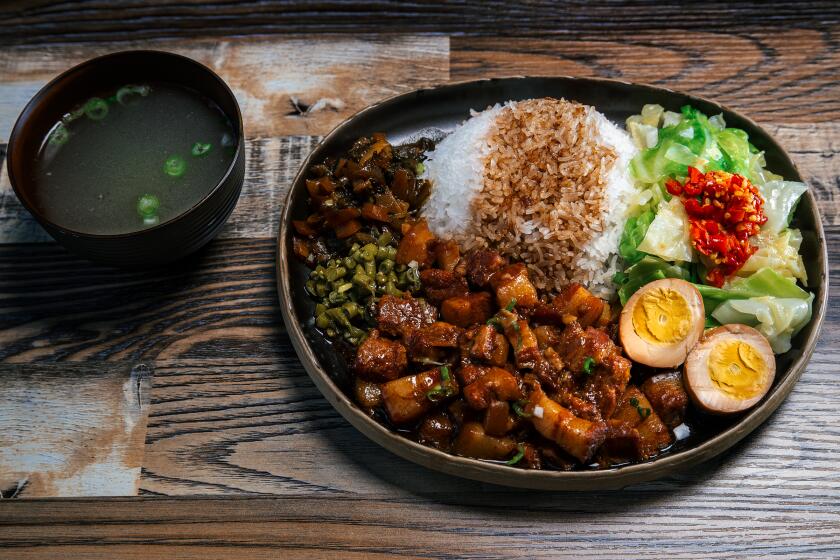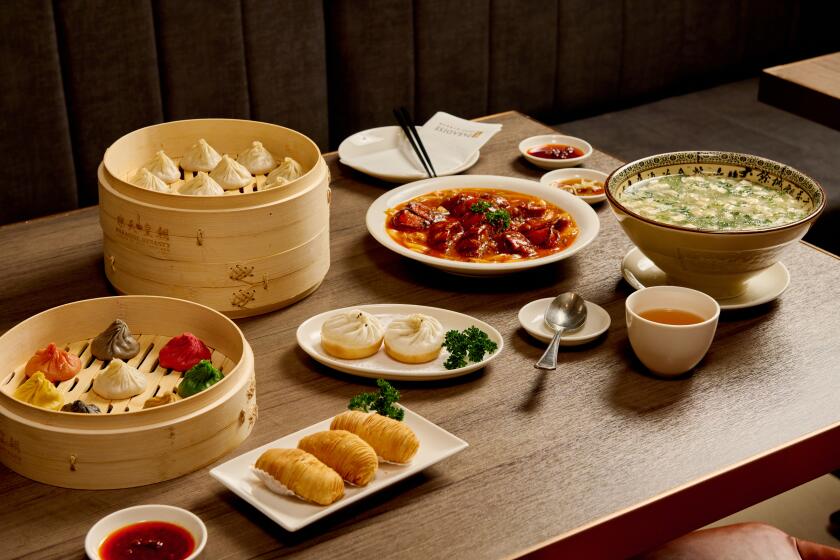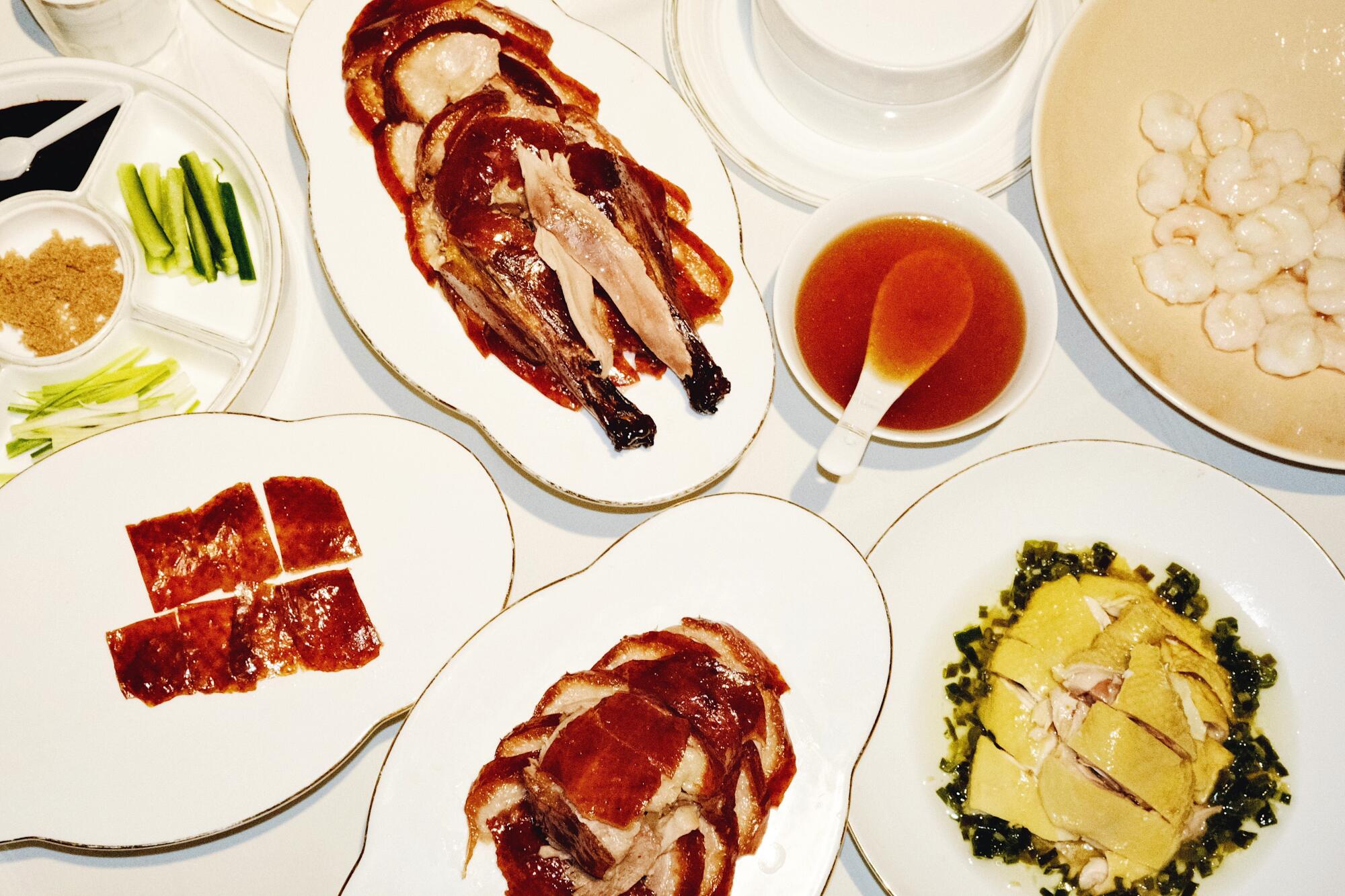
- Share via
No matter the culture, whatever the era, primal human wiring governs a truism: When a chef trundles a cart into a dark dining room and sets food theatrically ablaze, heads will turn from every direction.
At Array 36, an upscale Chinese restaurant in Temple City with a fantastical multimillion-dollar design, the flambéed focal point is a whole lacquered duck. The roasted bird hangs from a hook that juts out from the mouth of a swirling, gold-painted dragon sculpture.
A chef pours over erguotou (a clear variation on the Beijing-style spirit called baijiu distilled using sorghum and wheat), then aims a butane torch gun … and whoosh. Yellow and blue flames burst and surge upward for a few dramatic seconds. The metal, fire-breathing beast grins into the flickering glare.
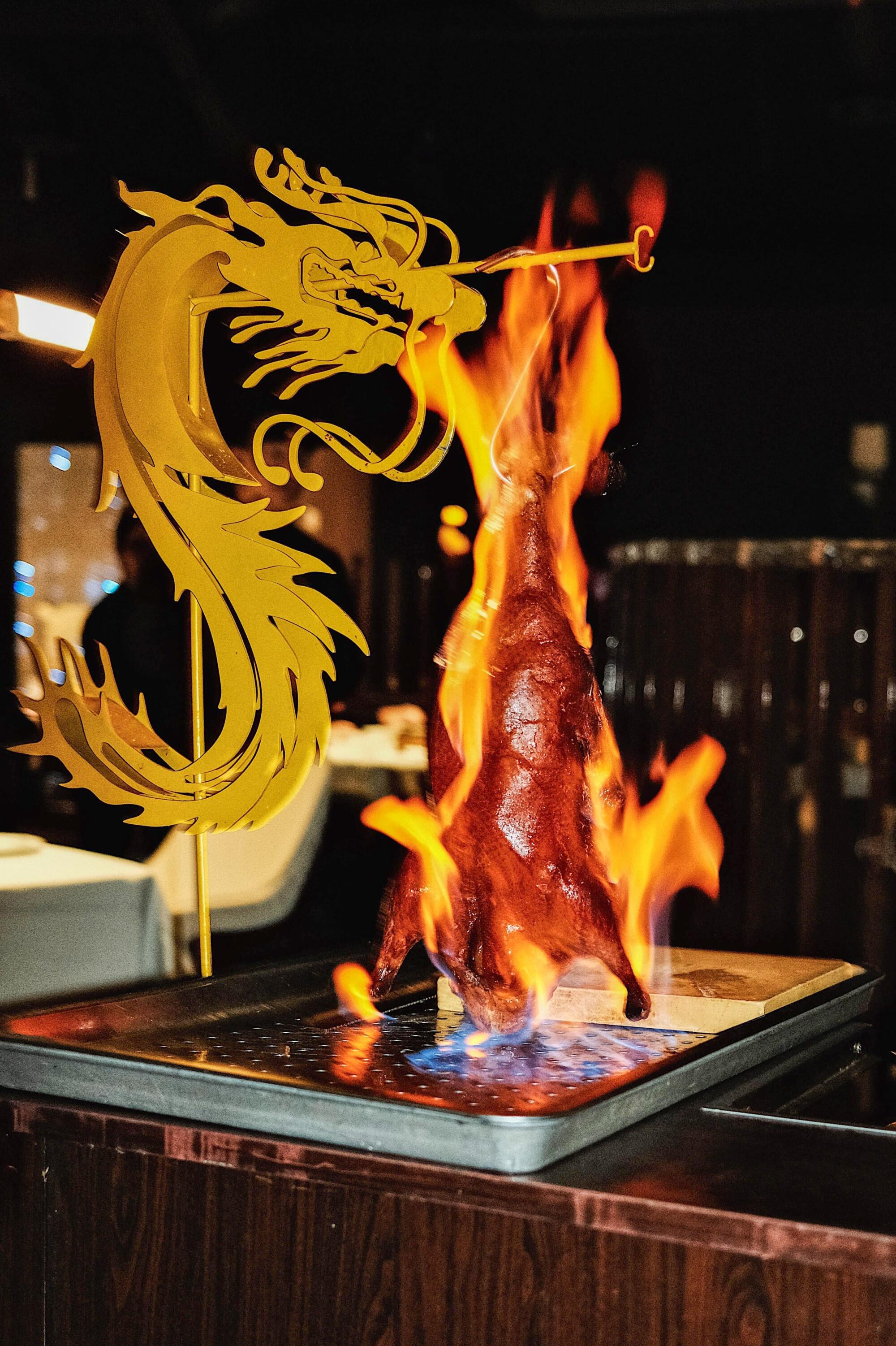
Then the flames die, and the chef goes to work. First up: a small plate of crisped skin, cleaved into squares, meant to be first dipped into brown sugar that’s in the center of a condiment tray. Then comes a pile of boneless slices of meat, garnished with more skin. A server delivers crepe-thin pancakes to wrap the duck with smears of hoisin and batons of scallion and cucumber.
Finally, the chef carves a second plate of meat onto an oval pedestal and situates it over a glass cloche outfitted for smoke infusions. The contents disappear in a cloud.
Half a minute later, the server rushes the vessel to the table and lifts off the dome, swirling the vapors. Just enough campfire perfume clings to the duck. We’ve disappeared so deep into the feast’s spell that we nearly forget to thank the chef for the performance before the cart moves on.
The “fire show,” as Array 36’s staff sometimes calls the presentation in English, is in heavy demand.
Diners make reservations here the old-fashioned way — by calling the restaurant, the only option — and anyone who wants the whole duck absolutely needs to request it ahead of time, and to hope that the limited number of them per night (around 20, I’m told) hasn’t yet been allotted.
Order the San Gabriel Valley newcomer’s lu rou fan, glazed pork belly served with rice and a collage of condiments — just one of Luyixian’s braised specialties.
No other tableside flourishes match its flamboyance, and the duck is consistent in its deliciousness, but on the whole, Array 36 aims for a performative sort of extravagance. Shanghai native Tony Tao oversees an extensive menu that leans to Shanghainese cuisine and the surrounding Jiangnan region but also wanders at will into Cantonese and Sichuan specialties and imagined dimensions beyond. It’s possible to order an excellent spread, but I learned by trial and error over several meals that included disappointments.
Friends with family connections across mainland China who joined me for lunch or dinner all noted that this style of restaurant feels familiar to them: a luxury refuge intended as much for impressing business associates as celebrating personal occasions, lined with private dining rooms of varying sizes and ornate decors for the highest rollers.
The main space falls somewhere between ornate and trippy in its ambiance. Muscle open the restaurant’s thick, gilded doors and step into a foyer where piano music trickles down from overhead in calming, single tones. It feels unmistakably like entering a spa.

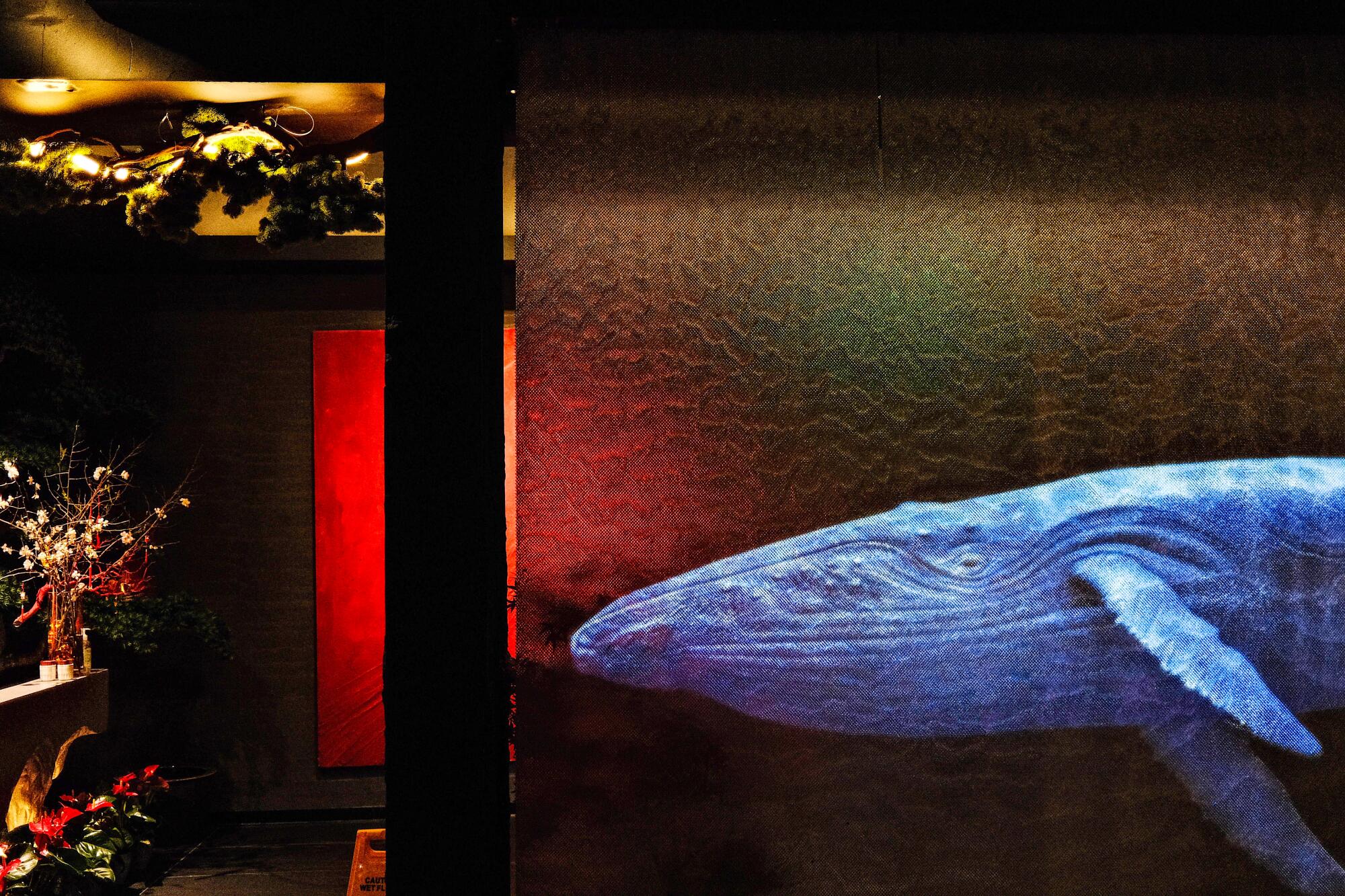
To the right, behind the host desk, mounted stone slabs glow a red-orange shade of eruptive lava straight out of an Indiana Jones adventure. Mist rises from underneath like volcanic steam. Two wall-size displays project a lone blue whale swimming an endless loop. Another form resembles a unicorn with cartoonish, drooping flesh.
Fake but seriously lifelike clusters of plants and patches of moss freckle the room’s landscape. A silvery sculpture dips and twists nearly across the length of the ceiling. Does it resemble a roller coaster? A comet’s winding path? A bored deity scribbling in the margins of space and time? You stare up from a table, forearms resting on starched white cloth, and wonder.
Then you return to studying pages and pages of dishes.
A few strategic suggestions gleaned from experience: Focus less on dumplings and bao and more on braises, fresh seafood and seasonal greens. I’m generally a fan of Shanghainese-style appetizers but found the cold poached chicken in scallion oil lacking seasoning and the smoked fish with preserved plums far sweeter than smoky, though a friend from the region pointed out that the almost sandy fried texture of the fish was correct and on point.
Paradise Dynasty is expanding to Glendale and will take on rival Din Tai Fung just across the way. But is it ready for the spotlight?
I’d prefer to start with soup, which I also found uneven: One listed on the regular menu, bobbing with stewed chicken with dried scallop and julienned cordyceps — yes, the fungi that went rogue in “The Last of Us”; none of us turned into clickers — let us down with the thinnest, blandest broth.
During a later dinner, a Cantonese friend was given a page of specials written only in Chinese characters (and if you know about it, servers are happy to provide it and translate). It listed a whole chicken soup, which arrived in a tureen big enough for a crowd and possessed the poultry-rich, silky broth I’d previously hoped for.
For solo portions, the special menu also mentioned individual lion’s head meatballs — paler than others I’ve tried locally but skillfully fluffy and intricately spiced — set in a ladleful of the same, intense broth.
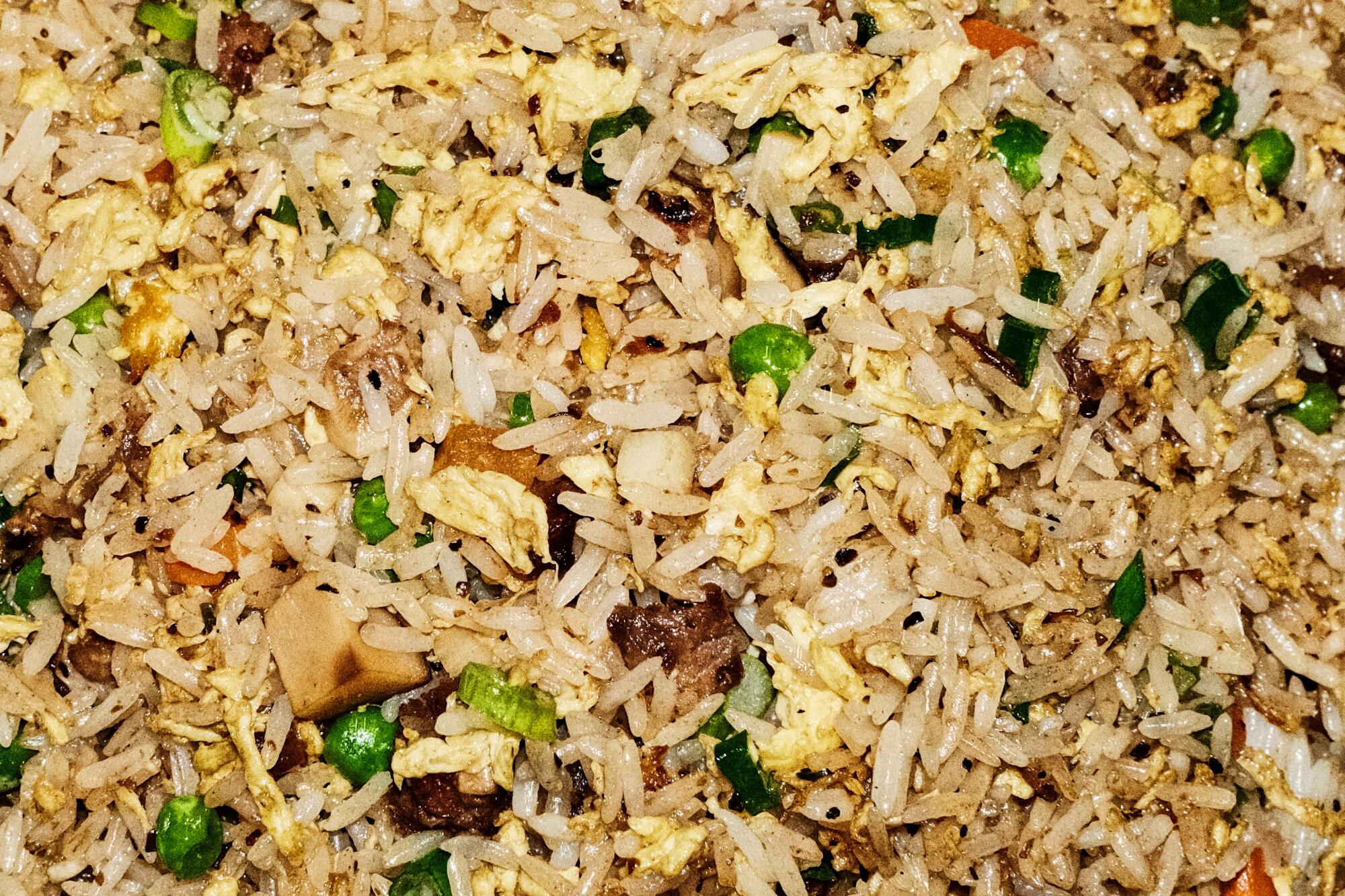
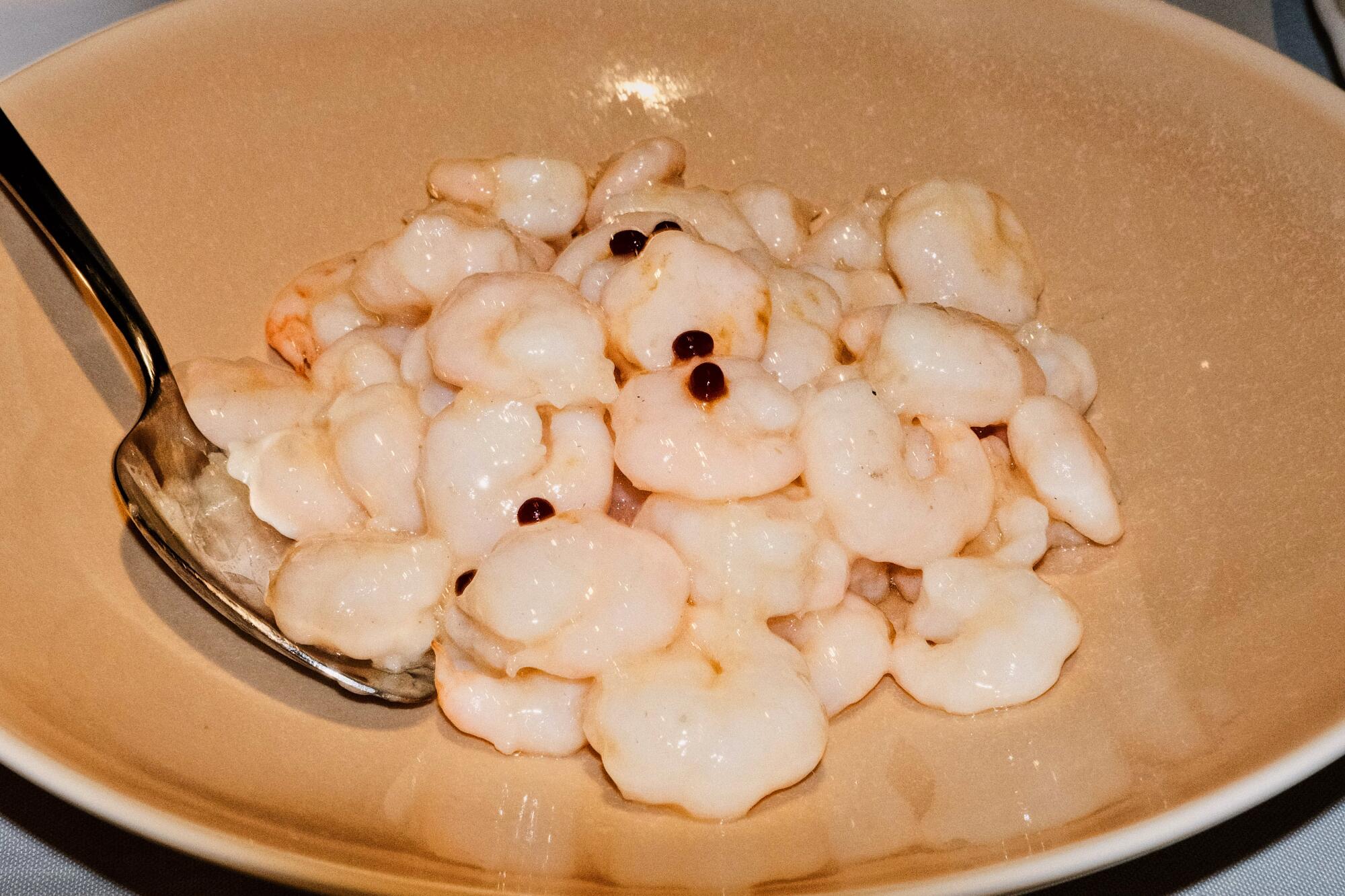
It’s not coincidence that my best meal at Array 36 happened with a group of six, including some tacticians especially skilled at ordering Chinese meals that achieve maximum variety and harmony. We savored the snap of stir-fried “river shrimp,” even though they were technically not those tiny specimens, especially with a taut dosing of the vinegar with which they were served.
Among a rotating selection of fresh seafood, the night’s only option was turbot, which we asked for Cantonese-style, steamed with ginger and scallions. The fish was as delicate and imbued with fragrance as any version I’ve had in Los Angeles.
“Array signature Shanghai braised pork belly,” so named among several variations on the theme, faithfully resembled hong shao rou, the red-braised pork belly famous to the region that’s crackly, aromatic and almost syrupy from dark soy sauce, ginger, garlic and the pronounced licorice nip of star anise.
“Slow-cooked Sichuan-style beef short ribs a la Française” turned out to be a rejiggered version of a standard at local Meizhou Dongpo restaurants. The meat has been sliced on the bone and splayed along four dips, including tingling powdered spices, oil suffused with minced garlic and ginger and a smooth green chile sauce. The staging leaned gimmicky, but the beef had been cured so the flavor distantly and satisfyingly recalled pastrami, and it made for a fun conversation piece.
Arguably my favorite dish: earthy-sweet snow pea leaves served in broth, crowned with roasted garlic cloves and chopped bits of ham, preserved egg and scallion. This stock too had been simmered to suppleness, with poultry undertones that united the garnish’s disparate flavors.
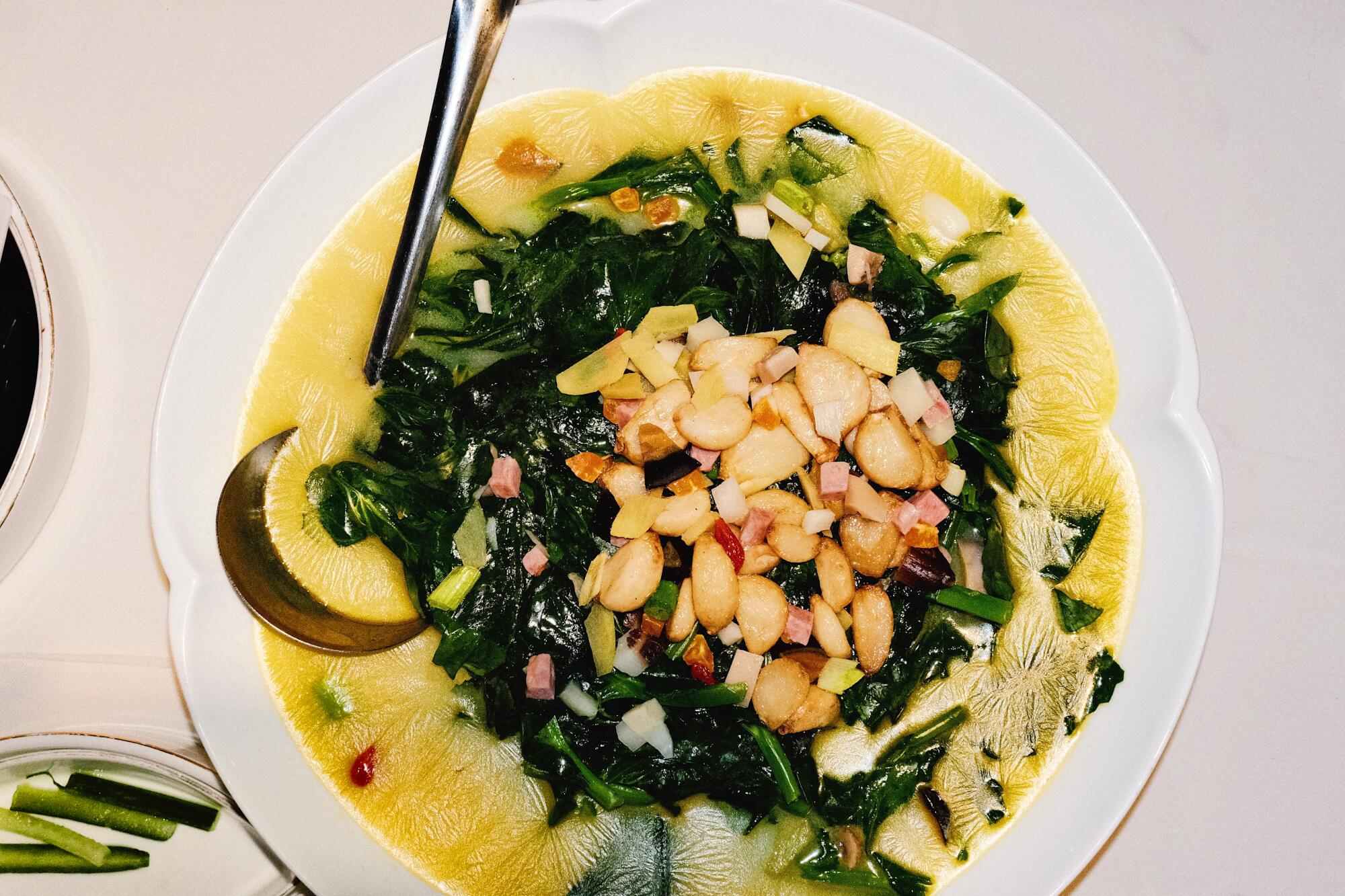
In the middle of all this, we had a fire show.
I’ve come to see the duck cart as an agent of chaos at Array 36. Likely it won’t appear at a well-timed place in the meal — right after soup or smaller plates, say, and before larger platters begin landing. The duck may appear moments after you’ve ordered, throwing off servers as they’re spooning other dishes into single bowls for each customer, or at the tail end as a grand conclusion when everyone is nearly full.
Requests for specific timing, at least on my visits, go unheeded. Like a megawatt star whose appearance makes or breaks an event, the duck comes when it comes.
The menu, I should note, also includes the option for a half-order of roast duck. The portion is generous, and it turns up among the shrimp and greens and pork, no pageantry, no disruptions.
But apparently, I live for the drama. The restaurant can take me only on a Monday at 5:30 p.m. for the last unreserved duck? Fine. When the blaze ignites, I peer into the burning gleam, grinning.
Array 36
5449 Rosemead Blvd., Temple City, (626) 508-5886, array36.com
Prices: Cold shared appetizers $10-$33, soups $8-$88 (including individual and large-format options), most shared entrees $19-$57.
Details: Lunch daily 11:30 a.m.-2:30 p.m., dinner daily 5-9:30 p.m. Menu includes a handful of very expensive bottles of wine. Plum juice is a good nonalcoholic option. Lot and street parking.
Recommended dishes: Roast duck “fire show,” whole chicken soup (on special menu), Shanghai-style stir-fried river shrimp, “Array signature Shanghai braised pork belly,” snow pea leaves (or other seasonal greens) in broth with garnishes.
More to Read
Eat your way across L.A.
Get our weekly Tasting Notes newsletter for reviews, news and more.
You may occasionally receive promotional content from the Los Angeles Times.
